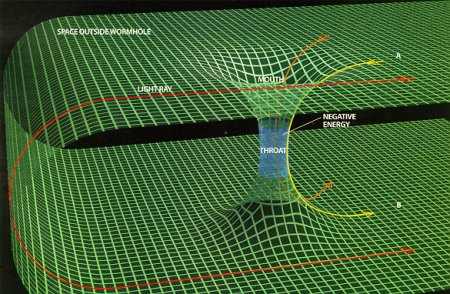
We didn’t either. This from Phys.org:
“In theory, the Milky Way could be a ‘galactic transport system’”
Based on the latest evidence and theories our galaxy could be a huge wormhole (or space-time tunnel, have you seen “Interstellar?”) and, if that were true, it would be “stable and navigable”. This is the hypothesis put forward in a study published in Annals of Physics and conducted with the participation of SISSA in Trieste. The paper, the result of a collaboration between Indian, Italian and North American researchers, prompts scientists to re-think dark matter more accurately.
“If we combine the map of the dark matter in the Milky Way with the most recent Big Bang model to explain the universe and we hypothesise the existence of space-time tunnels, what we get is that our galaxy could really contain one of these tunnels, and that the tunnel could even be the size of the galaxy itself. But there’s more”, explains Paolo Salucci, astrophysicist of the International School for Advanced Studies (SISSA) of Trieste and a dark matter expert. “We could even travel through this tunnel, since, based on our calculations, it could be navigable. Just like the one we’ve all seen in the recent film ‘Interstellar'”. Salucci is among the authors of the paper recently published in Annals of Physics. More.
And this from Universe Today:
Wormholes were first conceptualized by Albert Einstein and Nathan Rosen in 1935. Far from being fodder for science fiction, the two scientists instead proposed their idea as a way to get around the idea of black hole singularities. Rather than creating a knot of infinite density, Einstein and Rosen thought, the hefty energy inherent in such a massive body would distort spacetime to such an extent that it bent over on itself, allowing a bridge to form between two distant areas of the Universe. Alas, these wormholes would be extremely unstable and would require enormous amounts of “negative energy” to remain open.
But according to the team at SISSA, large amounts of dark matter could provide this fuel. Using a model of dark matter’s abundance that is based on the rotation curves of other spiral galaxies, the researchers found that the distribution of dark matter in the Milky Way produced solutions in general relativity that would, theoretically, allow a stable wormhole to arise.
An earlier study (Rahaman, et al., 2014 and Kuhfittig, 2014) has demonstrated the possible existence of wormholes in the outer regions of the galactic halo, based on the Navarro–Frenk–White (NFW) density profile. This paper uses the Universal Rotation Curve (URC) dark matter model to obtain analogous results for the central parts of the halo. This result is an important compliment to the earlier result, thereby confirming the possible existence of wormholes in most of the spiral galaxies. (You have to pay to read the article, but check the possibility that you might qualify to get it somewhere else for free.)
Some of us wish science today were more about moonwalks and less about what-ifs. But it would need different scientists.
Here’s a brief look at why so much speculation dominates science today.